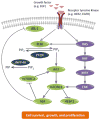PI3K pathway inhibitors for the treatment of brain metastases with a focus on HER2+ breast cancer
- PMID: 24469856
- PMCID: PMC3980725
- DOI: 10.1007/s11060-014-1369-6
PI3K pathway inhibitors for the treatment of brain metastases with a focus on HER2+ breast cancer
Abstract
The incidence of breast cancer brain metastases has increased in recent years, largely due to improved control of systemic disease with human epidermal growth factor receptor 2 (HER2)-targeted agents and the inability of most of these agents to efficiently cross the blood-blood barrier (BBB) and control central nervous system disease. There is, therefore, an urgent unmet need for treatments to prevent and treat HER2+ breast cancer brain metastases (BCBMs). Aberrant activation of the phosphatidylinositol 3-kinase (PI3K)/AKT/mammalian target of rapamycin (mTOR) signaling pathway is frequently observed in many cancers, including primary breast tumors and BCBMs. Agents targeting key components of this pathway have demonstrated antitumor activity in diverse cancers, and may represent a new treatment strategy for BCBMs. In preclinical studies, several inhibitors of PI3K and mTOR have demonstrated an ability to penetrate the BBB and down-regulate PI3K signaling, indicating that these agents may be potential therapies for brain metastatic disease. The PI3K inhibitor buparlisib (BKM120) and the mTOR inhibitor everolimus (RAD001) are currently under evaluation in combination with trastuzumab in patients with HER2+ BCBMs.
Conflict of interest statement
Dr. Hurvitz has received Novartis reimbursement for travel to international conference. Dr. Peddi has no conflict of interest to report.
Figures

Similar articles
-
Evolving strategies for overcoming resistance to HER2-directed therapy: targeting the PI3K/Akt/mTOR pathway.Clin Breast Cancer. 2010 Nov;10 Suppl 3:S72-8. doi: 10.3816/CBC.2010.s.015. Clin Breast Cancer. 2010. PMID: 21115425 Review.
-
Combination inhibition of PI3K and mTORC1 yields durable remissions in mice bearing orthotopic patient-derived xenografts of HER2-positive breast cancer brain metastases.Nat Med. 2016 Jul;22(7):723-6. doi: 10.1038/nm.4120. Epub 2016 Jun 6. Nat Med. 2016. PMID: 27270588 Free PMC article.
-
Potential of overcoming resistance to HER2-targeted therapies through the PI3K/Akt/mTOR pathway.Breast. 2015 Oct;24(5):548-55. doi: 10.1016/j.breast.2015.06.002. Epub 2015 Jul 15. Breast. 2015. PMID: 26187798 Review.
-
Preclinical modeling of combined phosphatidylinositol-3-kinase inhibition with endocrine therapy for estrogen receptor-positive breast cancer.Breast Cancer Res. 2011 Mar 1;13(2):R21. doi: 10.1186/bcr2833. Breast Cancer Res. 2011. PMID: 21362200 Free PMC article.
-
Phosphatidylinositol 3-kinase/AKT/mammalian target of rapamycin pathway inhibition: a breakthrough in the management of luminal (ER+/HER2-) breast cancers?Curr Opin Oncol. 2012 Nov;24(6):623-34. doi: 10.1097/CCO.0b013e328358a2b5. Curr Opin Oncol. 2012. PMID: 22960556 Review.
Cited by
-
PI3K/mTOR dual inhibitor BEZ235 and histone deacetylase inhibitor Trichostatin A synergistically exert anti-tumor activity in breast cancer.Oncotarget. 2017 Feb 14;8(7):11937-11949. doi: 10.18632/oncotarget.14442. Oncotarget. 2017. PMID: 28060760 Free PMC article.
-
Cancer brain metastasis: molecular mechanisms and therapeutic strategies.Mol Biomed. 2025 Feb 25;6(1):12. doi: 10.1186/s43556-025-00251-0. Mol Biomed. 2025. PMID: 39998776 Free PMC article. Review.
-
Advances in Imaging: Brain Tumors to Alzheimer's Disease.Bangk Med J. 2015 Sep;10:83-97. Bangk Med J. 2015. PMID: 29142857 Free PMC article.
-
Combined targeting of PI3K and MEK effector pathways via CED for DIPG therapy.Neurooncol Adv. 2019 May 28;1(1):vdz004. doi: 10.1093/noajnl/vdz004. eCollection 2019 May-Dec. Neurooncol Adv. 2019. PMID: 32642647 Free PMC article.
-
Treatments on the Horizon: Breast Cancer Patients with Central Nervous System Metastases.Curr Oncol Rep. 2022 Mar;24(3):343-350. doi: 10.1007/s11912-022-01206-2. Epub 2022 Feb 9. Curr Oncol Rep. 2022. PMID: 35138599 Review.
References
-
- Slamon DJ, Clark GM, Wong SG, Levin WJ, Ullrich A, McGuire WL. Human breast cancer: correlation of relapse and survival with amplification of the HER-2/neu oncogene. Science. 1987;235:177–182. - PubMed
-
- Geyer CE, Forster J, Lindquist D, et al. Lapatinib plus capecitabine for HER2-positive advanced breast cancer. N Engl J Med. 2006;355:2733–2743. - PubMed
-
- Brufsky AM, Mayer M, Rugo HS, et al. Central nervous system metastases in patients with HER2-positive metastatic breast cancer: incidence, treatment, and survival in patients from registHER. Clin Cancer Res. 2011;17:4834–4843. - PubMed
Publication types
MeSH terms
Substances
Grants and funding
LinkOut - more resources
Full Text Sources
Other Literature Sources
Medical
Research Materials
Miscellaneous

